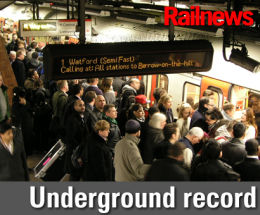Posted 7th November 2014 | 1 Comment
New passenger record on London Underground

THE number of people using London Underground is continuing to set new records, and is now rivalling the National Rail network.
Transport for London said the Underground carried 1,263.6 million people last year -- or 24.3 million passengers in an average week. The week starting 9 December last year saw 27.2 million journeys, as Christmas shoppers swelled the total. As records continue to be set, TfL has warned that 'sustainable investment must be guaranteed'.
Transport for London has also claimed that bus travel has reached new heights, but this is not so. The latest annual total available for buses is 2.4 billion passengers, which is much higher than 20 years ago, when 1993 saw a total of just 617 million journeys made, while the fleet at that time was little more than half its present size. However, the 2013 total is still dwarfed by the totals recorded soon after the Second World War. In 1953 the diesel buses operated by London Transport in Greater London carried almost 2.6 billion people and a further 747 million journeys were made on trolleybuses, whose routes are now included in the modern TfL bus network.
Even so, Transport for London is preparing for further growth, especially as London's population is set to increase from 8.4 million to 10 million by 2030. By 2050 demand for public transport is predicted to have increased by 60 per cent on the Underground and 80 per cent on National Rail, and TfL has called for further investment in its networks to be guaranteed.
Several major schemes to increase capacity are now underway or are being prepared. Schemes in progress range from Crossrail, which is due to open in 2018-2019, to a new branch of the Northern Line from Kennington to Battersea. Consultations have now started on a south-eastern extension of the Bakerloo Line from Elephant & Castle to Hayes and possibly Bromley, while proposals have also just been published for an Overground extension to Barking Riverside and a new tram loop in central Croydon. Beyond these schemes lies Crossrail 2, which is intended to run on a south-west to north-east alignment via Tottenham Court Road, potentially connecting towns in suburban Surrey with parts of south Hertfordshire.
Transport commissioner Sir Peter Hendy said: “Thanks to vital investment and a programme of modernisation we’ve seen delays cut and more frequent and reliable trains and buses. However, we have to keep looking towards the future, and continue the investment, to ensure our transport network keeps pace with the growing number of people who need it. Only through this can the network continue to be a driver of the UK’s economy, and maintain London’s position as a world-leading city.”
But Transport for London's bid to cut costs in a savings and efficiencies programme is meeting union opposition. TfL says its revised spending plans will have secured savings of 'up to £12 billion' by 2021, but rail unions, particularly the RMT, are locked in talks with TfL over the controversial plan to close nearly all London Underground ticket offices. The next generation of rolling stock for the deep tubes, unveiled by TfL in October, will also be capable of running in automatic mode without a driver in the cab.
Reader Comments:
Views expressed in submitted comments are that of the author, and not necessarily shared by Railnews.

Melvyn Windebank, Canvey Island, Essex
I reckon bus use is undercounted and the introduction of Borisbuses has made this worse as passengers like myself who use paper Travelcards issued by national railways outside London do not get recorded if they use the centre door or even rear platform whose ATTENDENT is only their to protect a hole in the back of the bus (!) and so those journeys are not recorded.
As to usage in 1953 well in those days very few people had a car and many people still lived close enough to walk to work or even school, something that is making a return with new city centre development !
Railways away from parts like Southern or Great Eastern were also under used and indeed under threat of closure . It's only since travelcards valid on all modes were introduced that many single journeys have switched from bus to rail ( e.g Hackney to Highbury on North London Line in place of bus route 30) .
The other major factor was London population was falling after WWII with severel million moving out along with factories to new towns another thing that has gone into reverse since the 1980s and Londons main problem now is dealing with success !